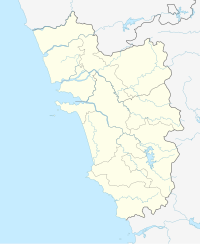Corjuem Fort
| Corjuem Fort | |
|---|---|
Forte da Assunção de Corjuem | |
| Part of Goa | |
| Bardez, Goa | |
| Coordinates | 15°35′48″N 73°53′34″E / 15.5968°N 73.8928°E |
| Type | Fortress battery |
| Site information | |
| Controlled by | Portuguese India(1705–1961) India(1961–present) |
| Open to the public | Yes |
| Condition | Partial Ruin |
| Site history | |
| Built | 1705 |
| Built by | Caetano de Melo e Castro |
| In use | Abandoned in 1894 |
| Demolished | no |
Fort Assunção[1] or Corjuem Fort is a fortress situated 4 kilometres (2.5 mi) from the village of Aldona on the river island of Corjuem, Goa. It was a military fortress for the defense of Portuguese India. It is smaller than the other forts in Goa, but it gives a good view of the surrounding river and land. It is a protected monument under the Goa, Daman and Diu ancient monuments and archaeological sites and remains act.[2]
Corjuem Fort is 12 kilometres (7.5 mi) from
Location
The Fort of Corjuem (Portuguese: Forte de Corjuem) is situated on an island with the same name in Bardez, to the east of the village of Aldona, from which it is separated by the Mapuçá River (a tributary of the Mandovi). It is one of the only two inland forts that are surviving that are made of pitted laterite.
History
The original occupiers of the island around the fort were the
In the early 1800s, the fort was used as a Military School and had in its defenses a battery of four guns. The fortress defended the town of
Incidents
The fort also has an interesting incident in which an ambitious Portuguese woman named
Santuário de Santo António de Lisboa
There is a Shrine dedicated to St. Anthony within the walls of the fort, at its entrance. It is under the ownership of the Parish of Aldona and is regularly patronized and renovated.
References
- ^ Joaquim Pedro Celestino Soares: Bosquejo das possessoes portuguezas no Oriente Imprensa nacional, 1851
- Times of India. Retrieved 21 August 2016.
- ^ pt:Caetano de Melo e Castro, Retrieved 10 May 2012[circular reference]
- ^ da Fonseca, José Nicolau (January 1878). Historical and Archaeological Sketch of the City of Goa. Thacker & Co. p. 85.
- ^ da Fonseca, José Nicolau (January 1878). Historical and Archaeological Sketch of the City of Goa. Thacker & Co. p. 86.
- ISBN 0864424884.
15°35′48″N 73°53′34″E / 15.59678°N 73.89281°E
- ^ "Corjuem fort to be developed as heritage touristic destination". timesofindia. Oct 2018.

